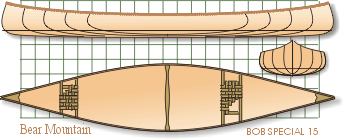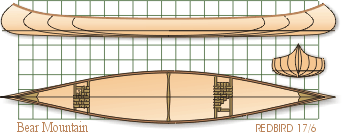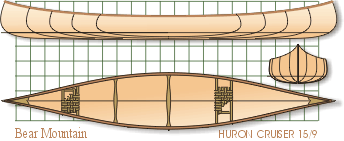Navigation
feedback
![]()
Return to: Home Page Canoeing Pages Routes and Photos Cedarstrip Project
Selecting a design (20/01/01)
(or how I chose to build a Huron Cruiser)
As a relatively experienced paddler I had a good idea of what I was looking for in a canoe. I also knew that it would be impossible to have everything I wanted in one canoe so certain compromises would have to be made. As this was going to be my first attempt at building a cedarstrip canoe I decided to choose an existing design that I could purchase plans for (as opposed to designing my own boat from scratch). In choosing a canoe design I went through 4 crucial steps:
2) Rank the characteristics according to priority.
4) Decide what modifications could be made to further optimise the design to my needs.
What follows is a more detailed description of those four steps.
First of all, I have a slight disability which prevents me from carrying heavy loads over long distances. At 70+ pounds my father's thirty year old fibreglass canoe was much too heavy for me to portage all but the shortest trails. Since I enjoy wilderness canoe tripping, often solo, my absolute priority was a very light canoe that I could portage myself without too much strain. So during the summer of 2000 I began to weigh my options. It was looking more and more like the only solution would be something like a Novacraft Bob's Special in the ultralight Kevlar/Spectra layup. I checked it out and it seemed a nice enough canoe and, at under 40 lbs, I could manage to portage it. However, at over $2000 plus taxes, and as a graduate student, I knew this solution was definitely not an option for the near future.
It was on one of the discussion forums at www.canadiancanoeroutes.com when someone told me cedarstrip canoes were very light and could be built for around $1000. This seemed much more reasonable to me and I thought it might even be fun to build. So weight and cost were the main reasons I decided to go the home-built cedarstrip route.
Paddling rivers with whitewater is one of my passions. So you would think I would stay away from a cedarstrip canoe. But even if I splurged on the Novacraft in Kevlar/Spectra (whitewater ABS canoes are too heavy), any damage from whitewater accidents would be permanent and/or expensive to repair. A cedarstrip canoe, on the other hand, is made of wood and a thin layer of epoxy and fibreglass - this is all relatively easy and inexpensive to repair. If I am careful, a cedarstrip canoe could be subjected to limited whitewater use. After all, paddling legend Bill Mason used a cedarstrip-canvas canoe in rapids. Besides, for the more rugged and radical rivers I would be tripping with friends and we would most likely rent proper whitewater canoes. But for wilderness tripping with limited whitewater use I needed something fairly tough, manoeuverable, and with good secondary stability (the ability to lean the canoe on its side without rolling over).
I also enjoy solo flatwater wilderness trips. I find that to get into the wilderness you really must go at least one portage into the bush - the more difficult to access the more remote and wild the surroundings. So two or three portages would be even better. So again, weight was important. I also found that when I paddled solo in my Dad's tandem canoe I was always trailing behind the group or, if alone, not making the progress or distance I would like to. So now I had a real problem because I wanted a canoe that was tough, manoeuverable, and stable enough for limited whitewater use but also capable of decent flatwater speed - characteristics at opposite ends of the canoe design spectrum. To put it crudely, one design is short and fat and the other long and lean.
To meet the above criteria I researched canoe designs from printed and electronic sources and came to the conclusion that I needed a design with certain physical features. Since I would be building the canoe with lighter weight materials than your typical cedarstrip canoe it was important to make up strength wherever I could - so a rounded hull with tumblehome (curving in at the gunnels), and preferably narrow, would be the strongest hull shape. Such a shape would also provide good secondary stability (stable when leaned - important for whitewater use) at the expense of initial stability (a tippy feel when level). As an experienced paddler I thought poor initial stability was something I could live with. Also, some rocker (curving up at the ends) would also be required for good turning ability in whitewater. A short canoe would also add to the manoeuverability and provide some weight savings at the expense of speed. But 15 feet was the shortest I thought I could go if I was going to use it for tandem and solo tripping. Since a long canoe would add to weight, and that was my most important consideration (see below), I would have to obtain flatwater speed by choosing a design with sharp entry lines (pointy and narrow at the ends). Speed would also be aided by being narrow in the middle - sacrificing cargo capacity, which was not a priority for solo tripping because I travel very light. I also wanted a "traditional" looking canoe with nice lines.
In order of priority, the design I was looking for would have to be 1) light in weight; 2) rounded hull with tumblehome; 3) approximately 15 feet in length; 4) narrow with sharp entry lines; 5) rocker; 6) 500-600 lbs cargo capacity (including paddlers); 7) "traditional", ie. symetrical.
Coincidentally, the three canoes I was considering were all Bear Mountain designs.
At first I thought of the Bob's Special:
It is a 15 foot tripping canoe with a good reputation as a tandem or solo boat. I had test paddled Novacraft's as well as Jay Morrison's 37 lb cedarstrip version. However, the Bob's has a relatively flat, wide bottom - not the best hull shape for strength. The entry lines are not very sharp so it is not all that quick - though not bad for a 15 foot canoe - and I wanted something with better solo speed. Still, this was my first choice during most of the summer.
I was also looking at the Redbird:
Even though it is a 17.5 foot canoe, I thought I could shorten it by two feet and still keep the best parts of the design. The more I looked at it the more I liked it. First of all, it has beautiful lines with the high recurve at the bow and stern. Few canoes are as good to look at. It is narrow with sharp entry lines, thus built for speed. It has the rounded hull shape and tumblehome I wanted. It even has some rocker for manoeuverability. Soon the Redbird was on the top of my list and I was pretty sure this was the canoe I would build. However, just before ordering the plans I asked people about their experience with this canoe. People on the internet told me the high bow meant it was difficult to handle in the wind. Since I would be doing a lot of solo paddling this could pose a problem. Still, it stayed at the top of my tiny list until I consulted the experts. The people at Bear Mountain suggested I speak to Ron Frenette at Canadian Canoes. To make a long story short, I called him and after listening to me he talked me out of it. He said that it was a very tippy canoe and the shallow draft meant it often took on water in waves. He also warned me about the wind problem. When I explained to him the kind of paddling I wanted to do and my priorities he suggested I look at the Huron Cruiser instead. Thanks Ron! The Redbird is a beauty but it was probably the wrong canoe for me.
The Huron Cruiser:
I don't know why I didn't consider the Huron Cruiser before. Maybe because I had the old edition of "Canoecraft", which doesn't have the Huron Cruiser in it. Even so, I did look at designs on the internet and the Huron was posted on Bear Mountain's web page. Yet I didn't even give it a second glance. As it turned out, the specifications of the Huron Cruiser were a closer match to what I wanted than either the Bob's Special or a shortened Redbird. At 15 foot 9 inches I could shorten it slightly to get even closer to my optimum design specifications without dramatically altering its handling characteristics. It has a narrow rounded hull with tumblehome; rocker; fine entry lines; a lower bow than the Redbird for improved handling in the wind and higher sides to keep out waves.
The following are my "proposed" design modifications and are mainly for weight reduction. These specifications may change as I go. If you have any other ideas, please e-mail me.
a) Shortening the Huron Cruiser by six or eight inches would get me closer to the 15 foot canoe I wanted. By shortening it in the centre only - by moving both #1 stations 3-4 inches closer to the centre station - I would get the biggest weight saving because the centre has the greatest area of wood, cloth, epoxy, and varnish. Furthermore, I don't want to alter the entry lines at the bow and stern in order to maintain as much of the speed characteristics as possible. Unfortunately, shortening it in the middle would be a detriment to cargo capacity. Even though the cargo capacity of a Huron Cruiser is already much less than either the Redbird or Bob's, it is not as important to me as other characteristics. Mainly because I already pack very light and 60% of the time I will probably be tripping solo and don't need the extra capacity. Hopefully, tandem partners and groups will be understanding!
b) I intend to use Sitka Spruce for most of the trim. Only the outer stem will be hardwood. While Spruce is not as strong as Ash or other hardwoods, it does have a very good strength to weight ratio and is said to be the best choice for trim when weight is an important factor. This should provide my biggest weight saving.
c) The hull will be White Cedar. Red Cedar is slightly heavier and not as strong.
d) Most builders recommend at least 6 oz fibreglass cloth on the inside and outside of the canoe. In order to maximise strength where it is needed most, and minimise weight, I have decided to layer 3 oz cloth accordingly. On the outside, the "football" (bottom) and around the bilge (the curve coming around to the waterline) will have the standard 6 oz coverage by layering two pieces of 3 oz cloth. Then from there up to the gunnels I will have only one 3 oz layer. On the inside I will also have two layers of 3 oz on the bottom and one of 3 oz up the sides. The total weight of cloth, and therefore epoxy resin that it will soak up, should be approximately 75% of the original design.
The original design weight of a Huron Cruiser is 45-55 pounds. I hope, with the modifications above, I will end up with a canoe just under 40 lbs. Time will tell.


